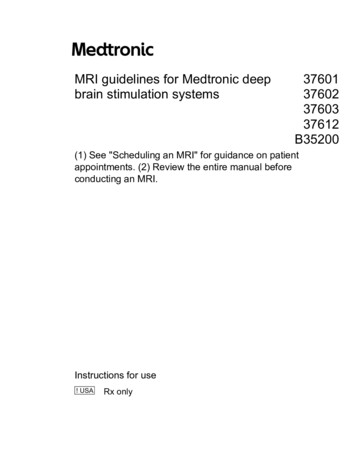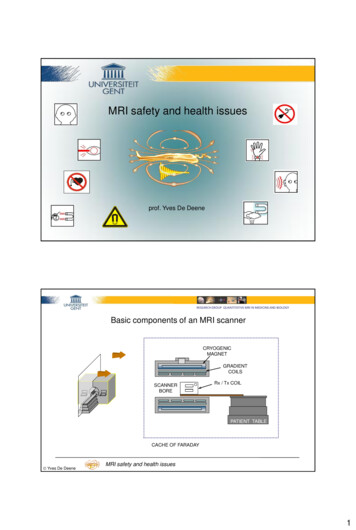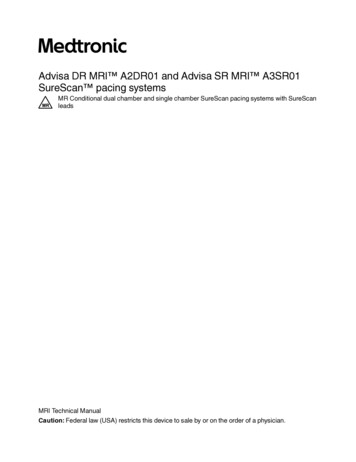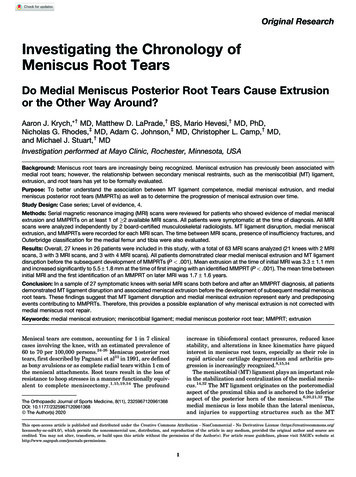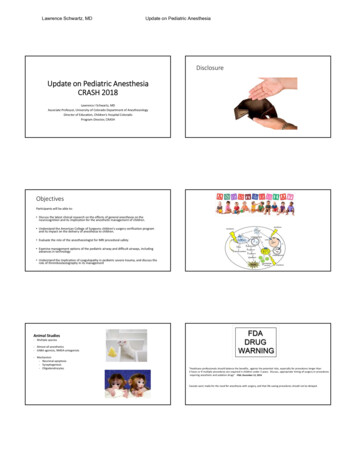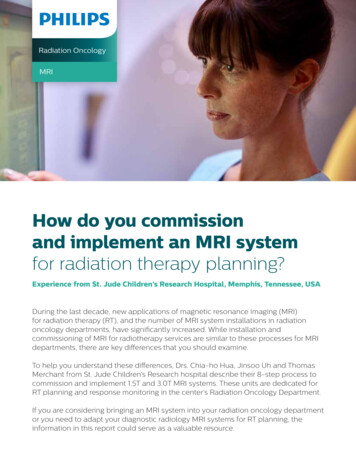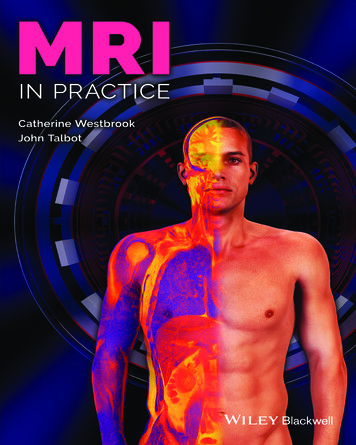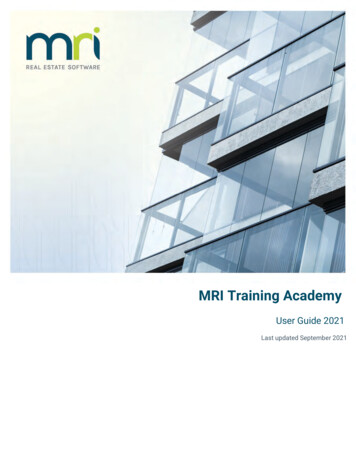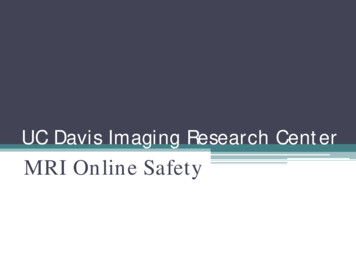
Transcription
UC Davis Imaging Research CenterMRI Online Safety
UCD IRC MRI SafetyWho should know MR Safety? All persons that have reason to enter the MR suite areashould be trained in MR safety procedures. Theseinclude but are not limited to: MR technologists, support personnel, researchers,research assistants Research volunteers and test subjects Maintenance and janitorial personnel Public safety forces (i.e. medical, law and fire personnel)that would respond to the MR suite for an emergencymust also know the potential hazards of the MRequipment.
UCD IRC MRI SafetyACR Zone RecommendationsAmerican College of RadiologyZone RecommendationsZone 1Zone 2Zone 1: Is the unrestricted area.Anyone is free to move about. Youwill have the participant completethe MRI screening form in Zone 1.Zone 2: Is restricted to card keyaccess. All persons must beaccompanied by Safety TrainedPersonnel.Zone 3Zone 4Zone 3: Consists of the scannercontrol rooms. Two Safety TrainedPersonnel must be available afternormal working hours.Zone 4: Consists of the MRIscanner. MRI Screening Form mustbe completed before entering.At UC Davis IRC you must follow the Zone recommendations
UCD IRC MRI SafetyACR Zone RecommendationsCompliance with the following protects you, subjects and guests: If you are the primary person responsible for the study remember that allsubjects, family members or guests must be accompanied by a safetytrained personnel. If you are having a guest observe your experiment and they will be enteringthe scan room, they MUST complete the MR screening form on each visit. The IRC receptionist is not allowed to open the electronic doors for yourguest. Please, give your guest the phone extension of the scan room so yourguest can call when they arrive. You will let them in, not the IRCreceptionist. Always have a line of sight on your subject, guests and other personnel thatare not safety trained to avoid potential accidents.
UCD IRC MRI Safety“Zone 2” Security and SafetyEntrance into “Zone 2” is secured by electronic locking doors. There are two electroniclocking doors: 1) from the lobby and 2) from the back entrance hallway. All visitors andsubjects must be accompanied by MRI Safety trained personnel into “Zone 2”. Thesedoors are locked for your protection and must never be left open as unauthorizedpersonnel may enter jeopardizing you or your subject’s safety. Violations will be subjectto review by the UC Davis IRC Safety Committee with possibility of, but not limited too,additional MRI Safety training and/or suspension.Entrance from lobbyEntrance from back hallway
UCD IRC MRI Safety“Zone 3” Security and Safety Final preparations and instructions are given to yourparticipant in Zone 3. All metal items must be removed in Zone 3 prior toentering Zone 4. Eating and drinking is not allowed in Zone 3 or Zone 4.
UCD IRC MRI Safety“Zone 4” Security and Safety The MRI scan operator or PI onsite is ultimately in charge, and must monitor allactions going into Zone 4 to ensure that all lab members and subjects complywith UCD IRC safety policies. If you have a subject or a subject’s guest in Zone 4, never leave them unattendedwithout a safety monitor present. This is a very dangerous safety violation whichwill result in immediate suspension. Never bring any unapproved equipment or objects into Zone 4. All equipment orobjects that are not approved will need to be submitted to the MRI safetycommittee for approval. Never leave the door open after you have completed your study. Confirm thatthe door is closed and sealed (toggle switch is in up position). In addition, at theSkyra MRI scanner, when the study is completed, lock the door going into Zone4.
UCD IRC MRI Safety“Zone 4” Security and SafetyThe following equipment must be MRI safe beforebringing into “Zone 4” – MR scan room: Non-ferrous IV Poles, Wheelchairs, Oxygen Tanks, Medical supplies,Gurneys, etc. Monitoring Equipment Testing Equipment not onsiteYou may see these stickers on some equipment. Thegreen sticker indicates it is safe in the magnet roomthe red sticker indicates that it is not safe in themagnet room.
UCD IRC MRI SafetySkyra 3T MRI: ACR Zones Zone 1 and Zone 2 are outside the Skyra MR scanner building.The MR screening form must be completed before enteringZone 3. When you enter the Skyra MR scanner building you will be inZone 3. Every precaution must be observed when bringingnon-MR Safety individuals into Zone 3. No one that has electronic implants is allowed in Zone 3 in theSkyra MR scanner. Zone 3 is separated by a red line on the floor. Go to the left ofthe red line and remove any metal on you and do not cross thered line to the MR console with any metal brought with you(i.e. pens, paper clips, binders, clip boards etc.).
ACR Zone Recommendations SkyraAll metal items mustbe removed in thissection to allow safecrossing of the redline, to prevent anymetal becomingprojectile in Zone 4.
UCD IRC MRI SafetyThe Magnetic Field of the MRI Scanner Is always on, 24hrs/day, 365 days/year. The magnetic field is on even when the magnet is NOT inuse. Even if the electrical portion of the machine is off or apower outage occurs, the magnetic field is still up. Anyone operating the MRI scanner and or acting as asafety monitor must be trained in MRI safety. The MRI Safety Officer has the final say in who may beallowed to go into the scanner room.
UCD IRC MRI SafetyTypes of Magnetic Fields in MRI Static (magnet) Field Gradient (time-varying) Field Radiofrequency (RF) Field
UCD IRC MRI SafetyMagnetic Field Strength Proportional to system field strength Less with lower field systems greater with higher fieldsystems
UCD IRC MRI Safety3Tesla MRI Scanners The main magnetic field of a 3T system is 60,000 times the earth'smagnet field. It is double the strength of a 1.5T operating system. It is important to remember that implants (i.e. orthopedicimplants, etc.) that are clear for a 1.5T magnet may not be safe fora 3T magnet unless it has been cleared for a 3T machine. Mrisafety.com has the largest database of items that are cleared forthe 3T environment The acoustic noise in a 3T system approaches twice that of the 1.5Tsystem as well. It can reach excess of 130 dBA, ear protectionand/or headphones must be used properly. Always check proper useof your participant ear plugs.
UCD IRC MRI SafetyForces in the MR Environment There are two types of effects the magnet willhave on Ferromagnetic substances Translation: The “Missile Effect” Rotation/Torque: The “Rotational Effect”
UCD IRC MRI SafetyTranslational Force: The Missile Effect Also referred to as the “Projectile Effect” and is used todescribe the attraction of the object to the center of themagnetic field This transforms objects into projectiles as they acceleratetoward the magnet These items can become airborne, accelerating at speeds of upto 40 miles per hour. This effect has repeatedly resulted in accidents jeopardizingthe safety of patients and staff, as well as the MRI equipmentitself.
UCD IRC MRI SafetyRotational/Torque Force: Rotational Effect This force relates to the North and South pole orientation ofthe scanner’s magnetic field Ferrous objects will attempt to align their long axes with thisorientation This force will rotate objects until they are aligned with themagnetic field. Translational and Rotational Force happen at the same timemaking objects projectiles and dangerous!
UCD IRC MRI SafetyMRI Safety - Projectiles Projectile effects of metal objects seriously compromise safety. This potential harm cannot be over emphasized. For example, paper clips can travel at a velocity of 40mph@ 3T. Larger objects travel at a higher velocity and may be fatal. *Do not bring any type or objects, especially metal objects,into Zone 4 unless approved by the MRI Safety Officer *
UCD IRC MRI SafetyMetal Objects Becoming Projectiles
UCD IRC MRI SafetyMetal Objects Becoming Projectiles
UCD IRC MRI SafetyAccidents CAN Happen! In 2003, a New Mexico woman sued claiming the magneticpull of an MRI scanner caused an oxygen tank to hit her in theback. In 2001, a 6 year old boy, was killed while undergoing an MRIwhen an oxygen tank flew out of the hands of a nurse towardthe machine, hitting him in the head. In 1992, a woman hemorrhaged and died after an aneurysmclip in her brain shifted while she was on a table preparing foran MRI procedure.
UCD IRC MRI SafetyItems that can be damaged by themagnet The magnetic field can seriously damage or impair thefollowing personal items: Cell Phones Watches Credit /Bank cards Hearing Aids Hair Accessories, Belt Buckles, Shoes Pocket Knives, Cigarette Lighters, Tie Clip Please remember to empty ALL pockets before entering thescanning room.
UCD IRC MRI SafetyGradient Magnetic Fields Gradient Magnetic Fields vary in intensity over distance, usedfor spatial localization. The loud banging noise is the gradientmagnetic field. Rapid switching of the gradient fields can induce current in aconductor (Faraday’s Law of Induction).
UCD IRC MRI SafetyGradient Safety Concerns Current Induction Peripheral nerve stimulation Caution should be used when using any type of wires in the MRI scanner. Acoustic Noise Hearing protection always used Greater with faster imaging sequences Increases with gradient strength
UCD IRC MRI SafetyPeripheral Nerve StimulationWhat Is It? Rapidly changing magnetic fields can, under certain conditions, causenerves close to the skin surface to become stimulated. The point where 50% of the population experiences PNS is referred toas the PNS Threshold. Peripheral Nerve Stimulation has beendescribed as a “involuntary muscle contractions”. The potential for Subjects experiencing PNS is very low-- but stillpossible.
UCD IRC MRI SafetyPeripheral Nerve StimulationWhat To Do? Be sure that the subject does not have their extremities crossed. PNSmaybe uncomfortable and more common with BOLD sequences.OLD sequences.
UCD IRC MRI SafetyAcoustic Noise The rapid alternation of current within the gradient coilscauses the loud banging sounds Some patients may experience discomfort from theassociated noise of the scanner. Prior to scanning it is mandatory to provide ear plugsand/or head phones are provided to the participant toreduce the noise level.
UCD IRC MRI SafetyRadio Frequency Oscillating magnetic field Responsible for heating of tissues Amount of RF (heat) deposition dependent on manyfactors which include Flip angle Field strength Pulse Sequence RF deposition is expressed by the Specific AbsorptionRate (SAR)
UCD IRC MRI SafetySpecific Absorption Rate The rate the subject absorbs the RF energy is described interms of Specific Absorption Rate (SAR), measured inwatts/kg. SAR is calculated by the patient’s weight and expectedincrease in body temperature for each imaging pulsesequence. Remember to enter the correct weight whenregistering. The scanner will calculate how much heat will be absorbed bythe patient per scan. If the SAR for the scan is too high thescanner will not let you run your scan.
UCD IRC MRI SafetyRadio Frequency Safety Concerns The FDA limits the amount of SAR – equal or less than 0.4Watts/kg averaged over the patient’s whole body and equal to or lessthan 8.0 Watts/kg average over any one gram of tissue. Communicate with your subject and listen for complaints of being towarm. Larger subjects have a tendency too get warmer quicker, avoid usingblankets and use the fan too circulate air.
UCD IRC MRI SafetyRadio Frequency Safety ConcernsSafety ConcernsAnother potential problem is whenusing EKG cables or other conductivecables. Do not loop the cablesbecause an induced current can occurcausing the wires to get hot causingburns to your subject. Always, place acloth material between the wires andskin to help prevent burns.
UCD IRC MRI SafetyWho must be screened before enteringthe scan room? Participants and their guests Nurses, Physicians, all medical personnel Environmental and POM personnel Emergency personnel (fire and police)EVERYONE!!!
UCD IRC MRI SafetyThe Screening Process - Researcher Every person that enters the MRI room must bescreened for possible contraindications that could affecttheir health and safety. As a PI, researcher, or research assistant you will need toinitially be screened as well. If there is ever any changesin your health please notify the MRI Safety Officer orTechnical Director.
UCD IRC MRI SafetyMRI SAFETY PRECAUTION NEVER enter the magnet room with any metal whatsoever. No metal in your pockets, no metal in your hands, no jewelry No credit cards or ID cards – they will be erased No flash drives, pens, scissors, lighters, pocket knives, keys, stools, or othertools – EVER. No one should enter the magnet room unless they have been screened formetal and are well aware of this issue.
UCD IRC MRI SafetySubject ScreeningAll subjects involved with a research study must have thefollowing two forms completed prior to any MRI scans: IRB Consent or Animal Protocol - An institutional review board (IRB), is acommittee that has been formally designated to approve, monitor, and reviewbiomedical and behavioral research involving humans with the aim to protect therights and welfare of the research subjects. MRI Screening - The establishment of thorough and effective screeningprocedures for patients and other individuals is one of the most critical componentsof a program that guards the safety of all those preparing to undergo magneticresonance (MR) procedures or to enter the MR environment. (Frank Shellock,Ph.D.)MRI screening must be completed for each study or visit for allindividuals (includes friends, family, and guests) that are not MRI safetytrained before entering Zone 4.
UCD IRC MRI SafetyThe screening form below is incomplete. Remember this is a legal document. All sections, dates, names, signaturesmust be completed before the subject enters the scan room. If it is incomplete it is not valid for a subject to bescanned and you could be liable for any damages or injury incurred by the subject. Do not modify or change the MRIscreening form without the approval of the IRC MRI safety committee. Complete the screening form on each visit.Missing PI’s name.Missing reviewers signatureNo date means it was neverreviewed .
UCD IRC MRI SafetySubject ScreeningThe following are red flags for additional investigation of MRIcompatibility prior to performing an MRI scan: Metallic Foreign BodiesBiomedical Implants and DevicesAneurysm ClipsElectronic implantsCatheters, Coils, Filters and StentsHeart ValvesPacemakers and Pacing WiresIntra-ocular Ferrous Foreign BodyPersonal belongingsPregnancy
UCD IRC MRI SafetyMRI Screening of ImplantsA subject that has an aneurysm clip orcardiac pacemaker in question, canbecome fatal in MRI. If a subject has oneof these implants do not scan them toprevent any potential fatalities causingdeath. Aneurysm clips can torque in themagnetic field, tearing the vessel causingan artery to bleed without immediateeffects. Subjects with pacemakers muststay in Zone 1 and never cross the 5 gaussline. Pacemakers will lose the calibratedsettings when placed in the MRI scannerchanging the demand, causing heartrates to fluctuate significantly.Aneurysm clipCardiac pacemaker
UCD IRC MRI SafetyMRI Screening of ImplantsExamples of two types of aneurysm clips. The right picture demonstrates ananeurysm clip that is highly attracted to the magnetic field compared to the leftpicture. Remember, any aneurysm clips are absolute contraindications and shouldnever be allowed for a research MR scan.
UCD IRC MRI SafetyMRI Screening of ImplantsIf you or your volunteer has any of these items, they can NOT beallowed into the scanning room Cardiac Pacemakers Cochlear (inner ear) implants Ferromagnetic or unidentifiable aneurysm clips of the brain Implanted neuro stimulators Metal or unidentifiable foreign bodies in the eyes Implanted pumps to deliver medicine that cannot be removed Full mouth braces or retainers that cannot be removed
UCD IRC MRI SafetyMRI Screening of Implants If participants have any type of implants (i.e. orthopedic hardware, heart stents,surgery clips, electronic implants, etc.), you cannot proceed with the MRI scanuntil written documents from the manufacturer, stating the conditions thatmust be followed to safely scan the participant and has been approved by one orall of the following IRC personal: Jerry Sonico, Cameron Carter and/or CostinTanase If a participant has had an MRI with an implant, never assume that theparticipant is safe to scan. You must still have approval before scanning yourparticipant. When approval of the implant is needed, have the name of the manufacture,name of the implant, model number of the implant, and physician’s operativereport. Always allow a minimum of seven days before appointment to confirm theconditions needed to safely scan the participant with an implant. If unable to acquire written documents confirming the conditions to safelyperform an MRI scan, the participant cannot be allowed to participate with theMRI scan. Violation of this policy are grounds for immediate suspension of the research laband all scheduled MRI scans will be cancelled until violation has been resolved.
UCD IRC MRI SafetyIntraocular Foreign Bodies X-rays of the eyes are needed to exclude metal foreignbodies in the eyes. If a subject is placed in the scanner with metal in theeye(s) this could result in damage to the retina and causepermanent blindness.Artifact on MRI caused bymetal in the eyeMetal in the eye seenon x-ray
UCD IRC MRI SafetyFinal Screening Tips Do not rely on the screening procedures from any other MRI facility to beadequate. Screen all visitors as if they were subjects. Screening should be done more than once – before entering the magnetroom, ask one final time, “is there anything in your body that you were notborn with!” Screening should be performed by MR safety trained individuals only. MR screening must be completed on each visit. Previous MR screeningforms may not be current with respect to a participant or guest MR safety. Implants that are safe at 1.5T may NOT be safe at 3.0T, always verify!
UCD IRC MRI SafetySubject MonitoringQ. Who should be monitored?A. All subjects should be monitoredverbally and visually.
UCD IRC MRI SafetySubject Monitoring Question: Who may require additional monitoring? Answer: Subjects who cannot communicate Subjects with weak voices Subjects who do not speak English Subjects who are sedated Subjects with diminished mental capacity
UCD IRC MRI SafetyHearing ProtectionUse of earplugs and/or head phones is always requiredregardless of static field strength. All subjects includingNHP (non-human primates) must use earplugs. Alwayscheck that your subject has correctly inserted the earplugs.
UCD IRC MRI SafetyEye Protection Eyes must be protected from laser light Instruct Subjects to close eyes when utilizing thelaser light for land-marking
UCD IRC MRI SafetySubject Alert System – Call Button This is the only communication while the MR scanner is operating When squeezed, the light on the control box illuminates Maintain verbal contact via system intercom Make available to all Subjects Cover bulb if latex allergies are present
UCD IRC MRI SafetyPregnancy Individuals at risk includes: Subjects, Family, and Guests Operators and Safety Monitors
UCD IRC MRI SafetyPregnancy Subjects Pregnant subjects are not allowed to have an MRI research scan. If thesubject might be pregnant, but is not sure, postpone the MRI researchscan until confirmed that the subject is not pregnant. Family or guests The same applies as above if the family member or guest will be stayingin Zone 4. Do not allow family or guest into Zone 4 if pregnant. Operators and Safety Monitors Are allowed in Zone 4 only when the MRI scanner is not operating (notmaking loud pulsing sound).
UCD IRC MRI SafetyTattoos There have been some documented cases of unusual sensation ortingling from a tattoo site during the procedure to receiving burns orraised skin at the site. The likely hood of this happening is very low but all subjects shouldbe aware of the issue before agreeing to take part in a study. Subjects with tattoos will be informed of the risks of tattoos in theMRI environment prior to the MRI study. At this time they willhave a chance to cancel the exam. If the subject complains of any unusual sensation during the examthe study will be immediately stopped.
UCD IRC MRI SafetyIncidental FindingsIn the event that you see something that appears abnormal on asubject’s scan, notify one of the following persons Jerry Sonico,Costin Tanase, or Cameron Carter and we will follow-up on yoursubject’s scan.StrokeParasitesAcoustic neuroma
UCD IRC MRI SafetyInfection Control The IRC’s role and scope of participation in infection prevention andcontrol includes those methods used in this department to reduce the riskof cross-contamination within the research subject population.The MRI scan table and head coil must bewiped with disinfectant solution after eachuse.
UCD IRC MRI SafetyAfter Study CompletionRemember to do the following before leaving: Complete the MRI session form, front and back. Email the IRC tech support if you encountered or noticed any equipmentproblems. Place all sponges back in the plastic containers. Return any cables to the same position to avoid any accidents (specificallythe response box cables). Clean up all trash and remember to gather up all your items. Confirm that all switches, buttons, software selections (i.e. audio andvideo) have been returned to the default position. Make sure the projector or monitor has been turned off. Put used laundry in the hamper.
UCD IRC MRI SafetyAfter Regular Hours scanning Always have a minimum of 2 MR Safety Trained personnel or a ratio of onesafety trained personnel to one non- safety trained personnel when youscan before 8am, after 5pm during the week, weekends and holidays.
UCD IRC MRI SafetyRestriction in the MRI Scan Suites Within the MRI suites(Zone 3 and Zone 4), food,beverages and tobaccoproducts are not allowed.There are no exceptions tothis policy.
UCD IRC MRI SafetyResponding to System Emergencies
UCD IRC MRI SafetyTypes of Emergencies Fire emergencies Medical emergencies Police emergencies Shutdown emergencies Quench emergenciesFOR ALL EMERGENCIES Dial911
UCD IRC MRI SafetyWhat you should know in EmergenciesMeet emergency personnel atthe electronic doors. Makesure emergency personnel areaware that the magnetic fieldis on and must not enterZone 4 (scanner room) withtheir equipment.
UCD IRC MRI SafetyEmergency – Fire EvacuationLocate the fire evacuation route map in case of fire. Fire alarms are atall exit doors. Pull fire alarm if fire occurs.
UCD IRC MRI SafetyEmergency – Fire ExtinguishersRed tank not MRI Compatible. Donot bring into the scanner roomSilver tank is MRI Conditional. Can bebrought into the scanner room
UCD IRC MRI SafetyMedical Emergency Subject EvacuationTypically Subjects can be evacuated from thescan room in less than 60 seconds.If a subject has a cardiac arrest,stops breathing, a seizure, or anyemergency requiring medical care,dial 911 and quickly remove thesubject from the scanning roomand transport them into thecontrol room. When emergencypersonnel arrive let them knowthat they are not to enter thescan room with their equipment onor injury could occur.
UCD IRC MRI SafetySubject Evacuation 1.5T211.5T Subject Evacuation1. Pull subject out of thescanner.2. Undock table by pressingfoot pedal at end of the table.3. Wheel subject into thecontrol room and securedoor to magnet room.3
UCD IRC MRI SafetySubject Evacuation 3.0T13.0T Subject Evacuation1. Pull subject out of thescanner.22. Put gurney along side ofscan table and pull subjecton to gurney.3. Wheel subject into thecontrol room and securedoor to magnet room.3
UCD IRC MRI SafetyEmergency - PoliceIf law enforcement is needed dial 911. The same precautionapplies, no metal must enter the scan room to avoid thedanger of injury.
UCD IRC MRI SafetyEmergency – Scan RoomEach magnet is equipped with two emergency buttons: Emergency Stop / Shut Off Turns off all incoming electrical power. The scanner electronicswill turn off, as well as, the operating computer. The magnetic field however will still be on. Quench or Emergency Run Down Causes immediate collapse of the superconductive magnetic fieldwithin a minute. The magnetic field will dissipate.FAMILIARIZE YOURSELF WITH THESE BUTTONS AND KNOWTHE DIFFERENCE!
UCD IRC MRI SafetyEmergency Stop / Shut Off Button Shutting power may be required forsituations such as: Fire in the computer room Fire, sparks, loud noises emanatingfrom the scan room Flooding or sprinkling system goesoff Catastrophic equipment failure Keep in mind that when this button ispushed, it does not initiate a quench,the magnetic field remains on.Exercise caution to make sure that allferromagnetic materials remainoutside of the scan room, they canstill become projectiles.Emergency Stop
UCD IRC MRI SafetyEmergency - QuenchOnce a superconducting magnet is rampedup and fully magnetized, it literally takes noadditional current or power to keep themagnet going. There's zero resistance -that's the "superconducting" part -- so thecurrent flowing in the magnet coils will runforever. That is, forever if the liquid heliumcooling the magnet is kept cold enough,which is quite close to Absolute Zero. If thecooling system becomes faulty, the magnetstarts to develop resistance, which causeheat, which causes more resistance, andmore heat, and so on until all the liquidhelium gets hot enough to become a gas,which then erupts in a jet-engine-soundingevent known as a quench. That's thousandsof dollars worth of helium you see in thephoto sequence going up in smoke.
UCD IRC MRI SafetyEmergency Run Down Button - Quench MR scanners are super cooled with helium. If these cryogens boil off either intentionally or unintentionally, aquench has occurred. This is extremely bad. An intentional quench is done in an emergency to run the magneticfield to zero. This is done in extreme situations only e.g. lifethreating situation where someone is trapped in or 0n the scanner. If a quench occurs, everyone must be removed from the roomimmediately. The vapors and gases are very cold and can causefrostbite. They also often condense the moisture in air, creating ahighly visible fog that can replace oxygen in the room andpotentially cause asphyxiation.
UCD IRC MRI SafetyQuench – What should you do? In the unlikely event of a quench and the vent fails, the procedure isto evacuate the Subject and all personnel from the magnetroom. Failure to follow these precautions can result in seriousinjury. Do not press the button except in a life threatening situation. The quench button will have a clear protective covering or yellowcover with a red “X” over the button so it cannot be pressedinadvertently. Do not attempt to test this button!
UCD IRC MRI SafetyQuench Buttons1.5T Scanner room Quenchbutton3T Control room Quenchbutton3T Scanner room Quenchbutton
MRI Magnet Room EnvironmentIf you are conducting a study that requires that you bring special equipmentinto the scan room other than equipment already there, it must be approved bythe IRC MRI Safety committee. Never assume that equipment issafe to bring into the scan roomuntil it has been tested Equipment not approved can causedamage and injury Equipment not approved can alsocause image artifacts and signalloss
UCD IRC MRI SafetyMRI Magnet Room EnvironmentApproval of items to be used during MRI Scansessions Items that are not already in Zone 4 (Scanner room) mustNOT be brought into Zone 4 without being first approvedfor MRI safety by the MRI Safety Officer. The item will be stored at the respective MRI scanningfacility (Davis or Sacramento) until the time of the scansession. This is to confirm that the item is not substitutedfor a similar item that has not been approved and broughtinto the MRI scanner. If an item is brought with the subject but has not beenapproved and is brought into Zone 4, this is a directviolation of this policy and the lab will be suspended anddisciplinary action will be taken.
UCD IRC MRI SafetyMRI Accidents or Incidents If you, visitors or subjects are involved in anaccident involving injury and/or an incident thatmay result in equipment damage, alwaysdocument the event and report it to the MRISafety officer within 24 hours. This will be reviewed by the IRC MRI SafetyCommittee for further corrective action.
UCD IRC MRI SafetyYou Have Completed the MRI SafetyTraining ModuleProceed to the MRI Safety TrainingQuiz. You must pass with at least 80%.
UCD IRC MRI Safety. ACR Zone Recommendations Zone 1 Zone 2. Zone 3. Zone 4. American College of Radiology Zone Recommendations. Zone 1: Is the unrestricted area. Anyone is free to move about. You will have the participant complete the MRI screening form in Zone 1. Zone 2:
